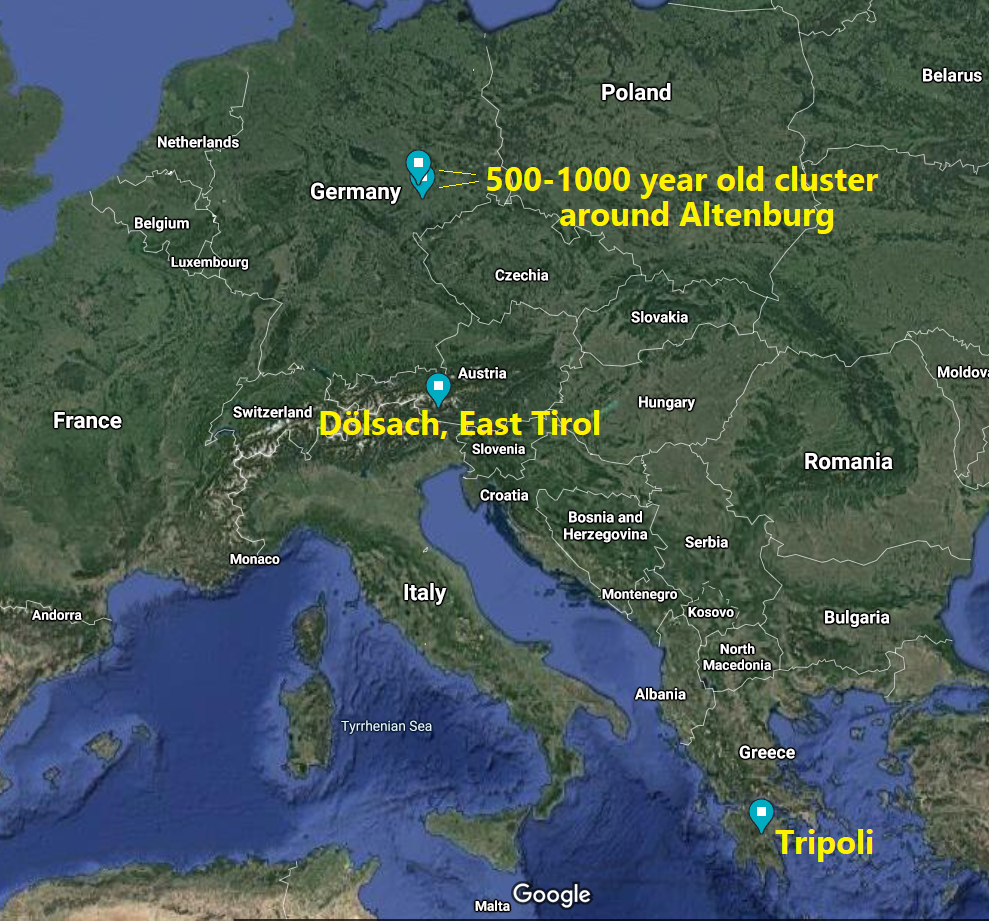J-BY177422 is one of the four newly discovered lineages below J-Z1043>FGC55778.
This is a freshly discovered lineage with no substructure and, to my knowledge, comprised of a single geolocated NGS sample, a man tracing male descent to Elstertrebnitz in 1886.
His closest relatives share a rare YCAII allele. One traces descent to nearby Schmölln, Thüringen. Their distance is GD 5/37 which I've approximated as roughly 500-1000 years ago, though most likely toward the old end of this range if not older.
Such geographic proximity - a 34 kilometer walk - for such potentially distantly related lineages is rare. It is also interesting to find such an old lineage of J-Z1043 in this part of Germany.
Most of our German J-Z1043 are from the Rheinland. This may reflect, in most cases, that their ancestors really came from those regions, but could partly be due to differences in regional sampling rates. People tracing descent to the Rhein test at a higher rate than Thüringen and Sachsen - with Rheinland Pfalz ranked #1, Baden-Württemberg #3, and Saarland #4 according to sample rate within Germany.
YFull Sampling Rates by Region in Germany
While I do not know of any STR matches to these Altenburg cluster men who trace descent to further south or west in Germany, it is interesting to note that Altenburg, a major city close to both men's origins, is known as one of the first German cities within former Slavic area, east of the Saale river (as part of the medieval Ostsiedlung movement).
The town (civitas Altenburg) was first mentioned in a deed to the Bishop of Zeitz in 976. Remains of a Slavic castle on the Schloßberg ("Castle Hill") demonstrate that the town was probably a Slavic foundation, the capital of the shire of Plisni, taken over during the conquest of Meissen by Henry I. As shown by placenames, the surrounding area (Osterland) was mainly settled by Slavs.- Altenburg, Wikipedia
Not related to genetics but interesting from a cultural standpoint, the German card game Skat was supposedly invented in Altenburg. I learned this game from my German host family during a student exchange and we visited the museum many years ago.
It will be interesting if we can find more of these men's STR matches who can provide their own male line origins. Then we may be able to more reliably assess the plausibility of the theory that their common ancestor may have migrated to this region from parts further south or west (I don't know myself from which specific part(s) of Germany the initial colonists to Altenburg would have come from). They have at least one other STR match from an unspecified location in Germany.
I say further south or west because one of the most plausible theories regarding J-Z1043 in Germany is that they descend from inhabitants of Roman cities along the Rhein or Danube frontiers who may have originally migrated there from the Balkans. This is not a proven theory but the circumstantial evidence has been steadily building.
We may soon have more circumstantial evidence to corroborate a Roman-mediated migration theory...

Two other men who share the same DYS464 allele 15-15-[17/18]-[17/18] trace descent to Dölsach, Tirol and Tripoli, Greece. They also share DYS385a = 10 which seems to have been acquired by J-FGC55778.
I have ordered today a SNP test for the man of Greek descent with the J-Z1043 Research Fund. The man Tirolean descent also plans to test. The town he traces male descent to was the site of the largest bath complex in Austria, known as Aguntum.
https://en.wikipedia.org/wiki/Aguntum#/media/File:2006-08-22_View_from_Aussichtsturm_Aguntum.jpg
If confirmed, it would mean that these men, along with those from near Altenburg, do in fact share a more recent common ancestor, one that lived potentially during or even before the Roman era. If positive, we'd recommend NGS testing followed by YFull analysis to get a more precise estimate of when their common ancestor lived.
Anyone can donate via Paypal to the J-Z1043 Research Fund to further research into the Iron Age origins of this prolific lineage of J-L283. Fund is used exclusively for purchase of tests and YFull analysis of NGS results.
The name of the place in Eastern Tyrol is Dölsach, not Dörlach. It belongs to the area of Lienz, the district capital.
Corrected, Thanks Michael!